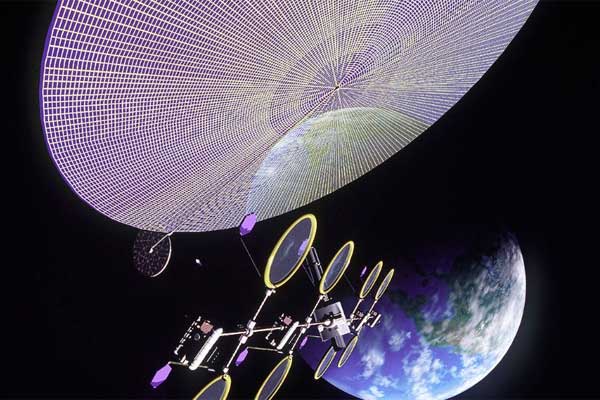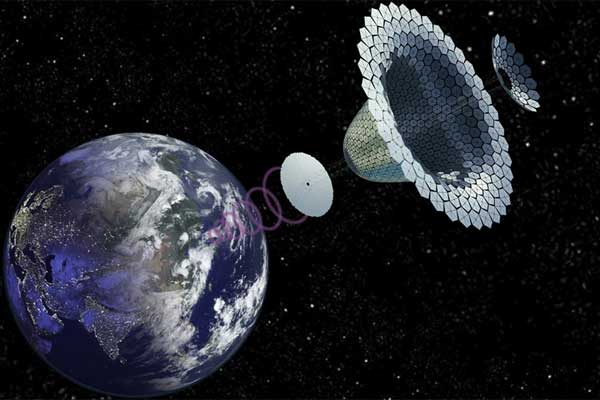The best spot for solar power isn’t California. It’s not the sub-Saharan desert or the wilds of the Australian bush.
In fact, the most potentially productive site for solar isn’t even on this planet—it’s miles above us, outside the Earth’s atmosphere.
Space-based solar power, or SBSP, has long been a dream of energy-minded scientists. Installing panels above Earth would allow us to take advantage of additional solar radiation that gets lost as sunlight travels through the Earth’s atmosphere—energy that can’t be harvested by conventional panels. And it would provide a more consistent energy source as well.
Temperamental terrestrial solar panels are subject to many fluctuations: cloud coverage, the changes seasons and of course, night all interrupt land-based production. In space, however, there are no such limitations.
Also arguing in the favor of SBSP is the fact that it would short-circuit the need for solar storage. Because conventional rooftop panels are dependent on environmental conditions, they can’t be counted on to generate reliable, dependable energy. You couldn’t, for instance, predict with a high degree of precision exactly how many watts of energy one installation will generate one any specific day.
But an inconsistent power source just isn’t an option in today’s world of stop lights, hospital devices, security systems and any number of other potentially life-saving technologies that depend on 24/7 electricity. Solar storage would allow a backup source of energy to draw from at night or whenever solar production was low.
Currently, however, storing solar energy means massive efficiency losses. Over time, stored electricity degrades, representing an energy loss. In fact, researchers estimate that with the current battery technology, homes relying strictly on solar + storage would consume 340 kilowatt-hours more energy, thanks to energy losses. SBSP would allow us to generate continuous renewable solar energy regardless of the weather, making more advanced storage systems unnecessary.

The logistics of building a solar power station in space are formidable and one solution would be to create ‘space tugboats’ to ferry payloads from low to higher orbits. In this artist’s concept, an electrically powered space tug equipped with a solar disk is used to bring materials from low earth orbit to geosynchronous earth orbit.
The Two Paths to Space-based Solar Power
There are two ways this could work. In the first scenario, satellites orbiting Earth harvest solar radiation. That radiation is then converted, first to electricity and then to microwaves or lasers that could be shot back to the Earth’s surface. Those transmissions would then be transferred back into DC output once they reached the ground.
The other option would be to install self-replicating solar panels on the moon. In a paper authored by then-high school senior Justin Lewis-Weber, Weber proposed a sort of solar factory on the lunar surface. Inside the factory, automated solar panels would build copies of themselves in order to construct a massive solar production site. The energy generated there would then be wirelessly beamed back to Earth for human consumption.
The Challenges Standing Between SBSP and a Stellar Energy Future
If such an operation seems like it’s straight out of Star Trek, don’t get too excited. There would still be plenty of obstacles to overcome before space-based solar power could ever become reality. First, the cost of building such a large, technologically advanced site would be enormous.
For instance, in the satellite scenario, the more likely of the two options, tons of equipment would need to be rocketed into space. But the current cost to send components into orbit is about $4,600 per kilogram. Former NASA physicist John Mankins, the author of the book The Case for Space Solar Power, estimates that the price would have to come down to about $400 per kilogram to make it cost-competitive with terrestrial solar energy.
Meanwhile, such a system would mean a total dismantling of the utility system. Utility company’s role would be as grid specialists, rather than as disparate power centers. One can imagine that might cause a dramatic overhaul in our current energy construction—something that utilities and their allies might not be all too happy about.
And of course, it would mean that we humans would have to cooperate as citizens of Earth, rather than separate nations or factions—something we haven’t proven ourselves to be all that good at in the past. As Elon Musk is fond of saying, we do have access to a giant fusion reactor in the sky: the sun. But we’ll only be able to use it efficiently if we can learn to see beyond our own personal interests.













Comments